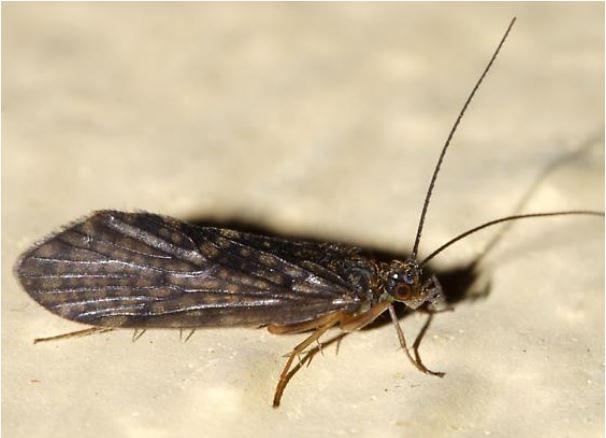The population size and trend of Northern Rocky Mountains refugium caddisfly is unknown in Washington.
Caddisflies are aquatic insects. They are very sensitive to water quality and changes in water flow. Caddisflies in general are often considered an indicator of high-quality streams, suggesting that they are particularly vulnerable to changes in their habitat.
Description and Range
Physical description
Caddisflies are closely related to the Lepidoptera (moths and butterflies). The adult’s body and wings are covered with long silky hairs (setae) – a distinctive characteristic of the order. Caddisflies are aquatic in the immature stages.
Ecology and life history
This species appears to inhabit streams as well as organic muck in spring areas. It is currently known from higher altitudes.
During the day, adults hide in cool, moist environments such as the vegetation along riverbanks. Few caddisfly adults have actually been observed feeding; they imbibe nectar.
Adults live several weeks and usually mate on vegetation or rocks surrounding water. Eggs, in masses numbering up to 800, are laid within a jelly that swells on contact with water. A female may wash off a partially extruded egg mass by dipping her abdomen into water during flight, or she may place the mass on stones in the water or on aquatic plants just above the water. Young larvae hatch within a few days and progress through multiple instars before emerging as a winged adult.
The larvae of G. baumanni are shredders and collector-gatherers, eating detritus and plant pieces. Although most larvae feed on aquatic plants, algae, diatoms, or plant debris, a few are predatory on other aquatic insects, crustaceans, and mollusks, and a few are omnivorous. The larvae play an important role in the aquatic community, reducing plant growth and disposing of animal and plant debris.
Caddisfly adults sometimes emerge in large numbers, often forming swarms. Adults tend to remain somewhat near the emergence site where oviposition occurs. They tend to disperse shorter distances in dense forest compared with more open vegetation. Although dispersal flights are common, such flights are relatively short and only occur immediately following emergence. In Montana, adults emerged mid-July to mid-August.
Geographic range
In Washington, this species is known from streams in the Big Spring Picnic Ground on Mount Spokane, Spokane County. Also reported from spring seepage areas in Missoula and Mineral counties, Montana and in Clearwater County, Idaho. In all three states, it is always reported in very low abundance.
For a map of range-wide distribution and conservation status of this species, check out NatureServe Explorer.
Climate vulnerability
Sensitivity to climate change
High
Goereilla baumanni is found only in few sites and always in very low numbers in Washington, Idaho, and Montana. They are restricted to cold headwater springs and seepage in high-elevation forested areas during their larval and pupae stages, and within this habitat are associated with the surrounding muck comprised of decomposing organic materials. Sensitivity for this species reflects their specialized habitat, which is particularly vulnerable to warming air and water temperatures, low summer flows, sedimentation from upstream erosion, and habitat fragmentation from nearby human activity (i.e. forestry practices and road construction). The close association of Goereilla baumanni to organic muck may make this species particularly sensitive to high temperatures, drought, and precipitation changes which may make these areas more likely to dry out. Caddisflies in general are often considered an indicator of high-quality streams, suggesting that they are particularly vulnerable to changes in their habitat.
Exposure to climate change
Moderate-
High
- Increased air and water temperatures
- Drought and/or changes in precipitation
- Low summer flows
- Increased sedimentation and erosion
Conservation
Conservation Threats and Actions Needed
- Resource information collection needs
- Threat: Lack of data on current status and distribution
- Action Needed: Determine distribution and population status
- Fish and wildlife habitat loss or degradation
- Threat: Water quality is of extreme importance to aquatic insects
- Action Needed: Protect riparian habitats
- Climate and severe weather
- Threat: Drying of streams
- Action Needed: Determine distribution and population status
See the Climate vulnerability section for more information about the threats posed by climate change to this species.
Resources
References
Clemson University Department of Entomology (J.C. Morse, ed.). 2002. Last Updated 5 September 2006. Trichoptera World Checklist. Online. Available: http://entweb.clemson.edu/database/trichopt/index.htm.
Denning, D. G. 1956. Several new species of western Trichoptera. Pan-Pacific Entomologist 32(2):73-80.
NatureServe. 2014. NatureServe Explorer: An online encyclopedia of life [web application]. Version 7.1. NatureServe, Arlington, Virginia. Available http://explorer.natureserve.org.
Stagliano, D. M., G. M. Stephens, and W. R. Bosworth. 2007. Aquatic invertebrate species of concern on USFS Northern Region lands. Report prepared for USDA Forest Service, Northern Region, Missoula, Montana.
B. Kondratieff, Colorado State University, pers.comm.
D. Ruiter, University of Texas, pers.comm.
